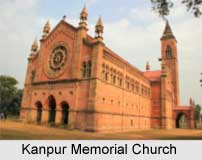 Kanpur Memorial Church is a church located in Kanpur. It was built in 1875 in honour of the British who lost their lives during the "Siege of Cawnpore" (Sepoy Mutiny, 1857). Kanpur Memorial Church, built in the year 1875, was designed by Walter Granville. This Memorial Church is usually called "All Soul`s Cathedral". The church is now popularly referred as the Kanpur Church. The church is situated on Albert Lane near "Cawnpore Club" in Kanpur Cantonment.
Kanpur Memorial Church is a church located in Kanpur. It was built in 1875 in honour of the British who lost their lives during the "Siege of Cawnpore" (Sepoy Mutiny, 1857). Kanpur Memorial Church, built in the year 1875, was designed by Walter Granville. This Memorial Church is usually called "All Soul`s Cathedral". The church is now popularly referred as the Kanpur Church. The church is situated on Albert Lane near "Cawnpore Club" in Kanpur Cantonment.
Architecture of Kanpur Memorial Church
The Church was designed by Walter Granville, an architect of east Bengal Railway. The Church has been erected in a Lombardy gothic style. Furthermore, it has been handsomely executed in bright red brick, with polychrome dressings. This Gothic style building has fine stained glass windows. The interior contains monuments to the mutiny, including several memorial tablets. The memoirs related to this church are truly heart wrenching. In the part enclosure to the east of the church is the Memorial Garden which can be approached through 2 gateways. This is separated from the main building through a handsome carved gothic screen that has been designed by one Henry Yule. Its center is occupied by the beautiful carved figure of an angle by Baron Carlo Marochetti, representing the "Symbol of Peace".
 The Cemetery has a number of graves from the late 19th century. The interiors of the church are decorated with the monuments to the mutiny, including several memorial tablets. The Memorials were relocated here after independence in 1948. The Military Cemetery on the edge of the cantonment contains a number of graves with interesting epitaphs from the late 19th century.
The Cemetery has a number of graves from the late 19th century. The interiors of the church are decorated with the monuments to the mutiny, including several memorial tablets. The Memorials were relocated here after independence in 1948. The Military Cemetery on the edge of the cantonment contains a number of graves with interesting epitaphs from the late 19th century.
History of Kanpur Memorial Church
According to the history of Sepoy Mutiny, the mutineers from the Kanpur Barrack laid siege to the barrack residential quarter that housed European officers and their family. The whole plan was masterminded by Nana Sahib who was a trusted ally of the British. The siege was opposed by handful of officers who were low on armouries but high on valour. In fact, their Enfield riffles were no match to the canon balls pounded by the British which were used by the mutineers. Nevertheless, against all odds, British officers were largely successful in saving the life of innocent womenfolk and children who got stuck there. But all came to end when Nana Sahib faked a siege fire and entered the fort somehow. The result was one of the deadliest massacres in the modern Indian history. Nana ordered every white-skin to be chopped in order to frighten and strike the steps of the reinforcement that was on the way to fight them. The order led to gang rapes and mutilation of women and children. The incident has been well chronicled in history and particularly in the novel "Cawnpore" that was based on the incident. Nana Sahib was notoriously bestowed with the title of "The Butcher of Cawnpore".
A visit to the attractive Kanpur Memorial Church brings visitors the gloomy truth of India`s struggle for Independence.





















